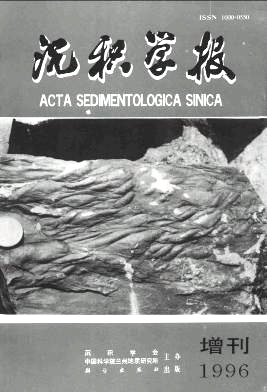Jing Maosheng, Sha Qing'an, Liu Min. Mixed siliciclastic-Carbonate Sediments during the Lower-Middle Cambrian in the North China Platform[J]. Acta Sedimentologica Sinica, 1996, 14(S1): 63-74.
| Citation:
|
Jing Maosheng, Sha Qing'an, Liu Min. Mixed siliciclastic-Carbonate Sediments during the Lower-Middle Cambrian in the North China Platform[J]. Acta Sedimentologica Sinica, 1996, 14(S1): 63-74.
|
Mixed siliciclastic-Carbonate Sediments during the Lower-Middle Cambrian in the North China Platform
- Received Date: 1996-03-20
- Publish Date:
1996-12-31
-
Abstract
Mixed siliciclastic-carbonate deposits from the Mandouian Formation to the Xuzhuangian Formation during the Early-Middle Cambrian in the North China Platform were interbeds of siliciclastic and carbonate rocks with high frenquency and mixed sediments with both siliciclastic and carbonate components. The former indicated interbeds of the mudstone and dolostone or the grainstone and silty shale, the latter formed the argillaceous dolostone, dolomitic mudstone, quartz calcarenite etc.The study on geochemistry of elements indicated the content of calcium gradually increased from the Mandouian to Xuzhuangian Formation with the increasing of limestone. But the content of magnesium decreased gradually with the decreasing of dolostone. Mg/Ca ratios were higher in Mandouianu Formation than in Maozhuangian and Xuzhuangian Formation.The content of trace element Sr was higher in limestone, 150-300×10-6 ;medium in argillaceous limestone, 100 ×10-6±;lower in argillaceous dolostone, mudstone and silty shale, 100 × 10-6. Sr/Ba1 in limestone, 1 in most mudstone and argillaceous dolostone. Mn=4000-13000 ×10-6in limestone,2500 ×10-6 in dolostone, 1000 × 10-6 in mudstone and argillaceous dolostone. The contents of Ti, Cr, Ni, V and etc. were higher in mudstone and silty shale, medium in argillaceous dolostone and dolostone, lower in limestone.The stable carbon and oxygen isotopic data of carbonate rocks indicated that the variant scale of isotopic values was greater in the Mandouian and in the lower part of Maozhuangian Formation, δ13C: - 2. 59‰─+1.14‰ (PDB) and δ18O:-14. 89‰── 4. 71‰ (PDB); while they were smaller in the upper part of Maozhuangian and in the Xuzhuangian Formation, ─2.25‰──0. 37‰ (PDB),─ 10. 07‰── 7. 95‰ (PDB) respectively. It could be deduced that the sea water was relatively shallow during the Mandouian and the early Maozhuangianstage,thus minor scale sea level changes could cause the changes of salinity, reduction-oxdation conditions, temperature and circulation of sedimentary environment, till the late Maozhuangian and Xuzhuangian, the sea water became relatively deep and sedimentary environment was stable.It was considered that transgression expanded gradually from the Early to Middle Cambrian in the North China Platform. The terrigenous deposits and dolostone decreased but limestone deposits increased from the Mandouian to Xuzhuangian. During Mandouian the transgressive cycles were deposits of parasyngenetic dolostone and regressive cycles were mud deposits, from Maozhuangian to Xuzhuangian the transgressive cycles were grainstone and regressive cycles were silty shales. The third sea level changes showed a model of rapid transgression and slow regression.
-
References
|
[1]
|
1.王英华等.华北地台早古生代碳酸盐岩岩石学.北京:地展出版社.1989, 2-27.
2.冯增昭等.华北地台早古生代岩相古地理.北京:地质出版社.1990. 28-40.
3.叶连俊等.华北地台沉积建造.北京:科学出版社,1983, 1-7.
4.刘英俊.曹励明.元t地球化学导论.北京:地质出版社,53-55.
5.洛正,.华北地台寒武纪沉积建造.叶连俊等著.华北地台沉积建造.北京:科学出版社,1983, 49-63.
6.落正褚,李菊英.白云岩化作用与中国东部白云岩地层.中国科学院地质研究所集刊(第4号),北京:科学出版社,1990, 1-98.
7.Folk R L&Land L S. Mg/Ca ratio and salinity; two controls over crystallization a1 dolomite. Am. Assoc. Petrol. Ge-ol. F3ull.. 1975. 59 (1):60-68.
8.Imbrie J and Imbrie J Z. Modebng the climatic response to orbital variations. Science, 1980, 207: 943-953.
9.Keith M L and Weber J N. Carbon and oxygen isotopic compsition o1 selected limestones and fossils. Geochim. Cos-mochim. Acta. 1964,28: 1787-1876.
10.Matthews S C and Cowie J W. Early Cambrian transgression. Journal of the Geological Society. 1979. 136: 133-135.
11.Mokie T. Relative sea level changes and the development of a Cambrian transgression. Geol. Mag. 1993. 130(2):245-256.
12.Read J F. Controls on evolution of Cambrian一Ckdovician Passive margin. U. S. Appalachians. In: Crevello P Det al. (eds),Controls on carbonate platforms. Geological Society America Bulletin. 92: 197-211.
13.Schlager J F. Carbonate sequence stratigraphy. 1n: wilgus C K. Hastings B S. Kendall C G St C. Posamenter H W.Ross C A and van wagoner J C eds. Sea一level changes: an intergrated approach. SEPM Spec. Publ.42: 155-181.
14.Williams D F. Evidence for and against sea一level changes from the stable isotopic record of the cenowic. In: Wilgus C K et al (eds),Sea一level changes: An integrated approach. SEPM. Spec. Publ. 1988. 42: 31-37.
15.Wright V P. Speculations on the controls on cyclic peritidal carbonates:ice一house versus green house eustatic controls,Sediment.,GeoL,1992, 76: 1-5.
16.Vad P R. Mitchum R M, et al. Seismic stratigraphy and global changes in sea level. In: Payton C E (Eds) Seismic stratigraphy一applications to hyr'-ocarbon exploration. American Association of Petroleum Geologists Memoir 26:99-212. |
-
-
Proportional views

-






 DownLoad:
DownLoad: